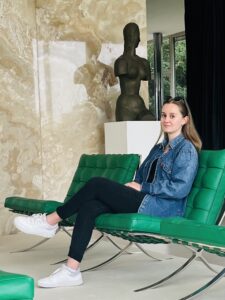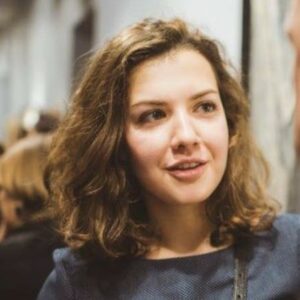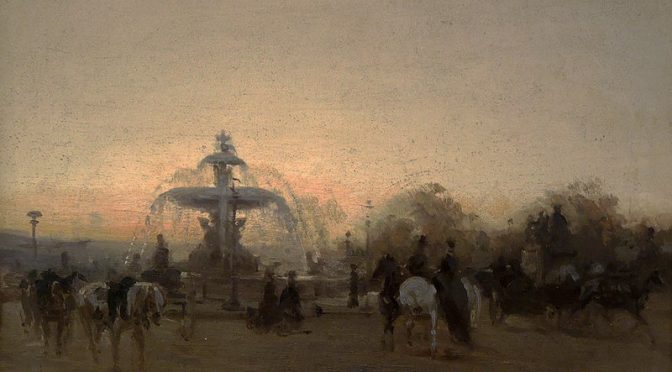Théorie et pratique de l’architecture à Bratislava vers 1800
Axe 3. Objets, traces, mises en carte : espaces au quotidien
 Dominika Drobná est doctorante au Département d’histoire de l’art de la Faculté des arts, Université Comenius à Bratislava. Sa dissertation Théorie et pratique de l’architecture à Bratislava vers 1800 contribue à l’axe de recherche 3 du CEFRES.
Dominika Drobná est doctorante au Département d’histoire de l’art de la Faculté des arts, Université Comenius à Bratislava. Sa dissertation Théorie et pratique de l’architecture à Bratislava vers 1800 contribue à l’axe de recherche 3 du CEFRES.
Le but de cette recherche est d’explorer la relation entre la théorie et la pratique architecturales à Bratislava entre 1770 et 1830. Sa recherche a commencé en se concentrant sur le développement de l’architecture sacrée dans l’ouest de la Slovaquie au cours de cette période, en particulier dans le contexte des réformes thérésiennes et joséphines dans l’Église et l’éducation. Ces réformes ont eu une influence considérable sur la production architecturale et ont conduit à la découverte d’une figure jusque-là négligée dans la théorie architecturale – Johann Nepomuk Schauff. Schauff a travaillé pendant de nombreuses années comme professeur de dessin à la Normalschule à Bratislava, où il enseignait le dessin aux artisans locaux, notamment les maçons et les tailleurs de pierre. Ces artisans participaient de plus en plus aux conceptions architecturales, notamment dans les bâtiments religieux et séculiers, souvent en collaboration avec des architectes viennois. Schauff a également développé ses propres idées théoriques, axées sur l’architecture du Royaume de Hongrie et publié plusieurs œuvres à Bratislava liées à ce sujet.
Sa recherche examine également les travaux de Matthäus Walch, un architecte qui a travaillé à Bratislava pendant les années 1770. Walch a joué un rôle notable dans la construction de plusieurs palais aristocratiques, d’un théâtre et de deux églises évangéliques, construites même avant la publication de l’Édit de tolérance (1781).
L’objectif principal de sa recherche est d’aborder les aspects théoriques et pratiques de l’architecture – en particulier l’architecture sacrée – en analysant les travaux et les idées de ces deux figures importantes. Elle se propose de suivre le développement stylistique de l’architecture de Bratislava pendant la période de transition du Baroque au Classicisme, et de montrer l’importance de Bratislava en tant que centre secondaire d’architecture et d’art dans la monarchie des Habsbourg et au Royaume de Hongrie.
La méthodologie de sa recherche se compose de plusieurs phases. La première est une évaluation critique et heuristique de la littérature existante. La deuxième est une analyse approfondie des sources historiques primaires, parmi lesquelles figurent les documents d’archives, les cartes, les plans architecturaux et les représentations historiques, notamment les estampes. Elle porte une attention toute particulière aux textes théoriques de Schauff, dont l’interprétation aide à mettre en lumière le discours architectural vers 1800.
La base matérielle de se recherche est constituée de trois édifices sacrés majeurs à Bratislava : La Grande Église évangélique (1774-1776), La Petite Église évangélique (1776-1777), et l’Église catholique romaine de Saint Ladislas (1830-1831). Il faut noter que les deux églises évangéliques ont été construites avant l’Édit de tolérance (1781). A la suite d’une analyse compréhensive des ces édifices, les traits caractéristiques de l’architecture de la période et de la région concernée seront déterminés à partir d’une comparaison, et leurs développement et style seront définis. Dans la dernière phase, elle s’attachera à interpréter les connaissances acquises sur l’architecture sacrée. Elle vise à examiner le contexte plus large du problème à l’étude dans l’architecture de cette période, non seulement dans le territoire de la Slovaquie actuelle, mais aussi en Hongrie, dans la monarchie des Habsbourg et en Europe.
Formation
- 2022-présent : doctorante, Les études en arts, Département d’histoire de l’art, Faculté des arts, Université Comenius à Bratislava
- 2021-2024 : Master, Archéologie, Département de l’archéologie et muséologie, Faculté des arts, Université Masaryk à Brno
- 2019-2021 : Master, l’Histoire de l’art, Département d’histoire de l’art, Université Masaryk à Brno
- 2016-2019 : Licence, l’Histoire de l’art, Département d’histoire de l’art, Faculté des arts, Université Comenius à Bratislava
Publications récentes
- Šintava a Sereď: premeny stredovekého hradu na renesančnú pevnosť a klasicistický kaštieľ: doklady vo svetle poznatkov z oblasti archeológie, dejín architektúry a pamiatkovej starostlivosti [Šintava and Sereď: la transformation d’un château médiéval en une forteresse Renaissance et un manoir classique : preuve à la lumière des connaissances dans le domaine de l’archéologie, de l’histoire de l’architecture et de l’entretien des monuments]. In: Studia archaeologica Brunensia, roč. 29, č. 1, 2024, s. 109–151.
- Vila pro stavitele (Villa for the Builder). In: Tajemství české minulosti, č. 103, 2024, s. 24–27.
- Bratislavskí stavební majstri a ich vplyv na premeny mesta v druhej polovici 18. Storočia [Maîtres d’œuvre de Bratislava et leur influence sur la transformation de la ville pendant la seconde moitié du 18ème siècle]. In: Umělec a město: sborník příspěvků z odborné konference. Brno 2023, s. 91–104. ISBN 978-80-88145-69-1.
- Kontexte der Kunst um 1800 aus dem Gebiet der heutigen Slowakei [Contextes de l’art vers 1800 du territoire de la Slovaquie actuelle]. In: Internationales Doktorand/innen Forum Kunstgeschichte des östlichen Europas [elektronický dokument]: Beiträge / Papers 2023. Berlin 2023, s. 1–2.
- Možnosti inšpirácie architektúrou [Possibilités d’inspiration à travers l’architecture]. In: Prostor Zlín, roč. XXX, č. 4, 2023, s. 43–47.
- Pressburger Baumeister Matthäus Walch a jeho stavebná činnosť v Bratislave [Pressburger Baumeister Matthäus Walch et ses activités de construction à Bratislava]. In: Kolbiarz Chmelinová, Katarína – Beňová, Katarína: Umenie a umělci v meste okolo roku 1800. Bratislava 2023, s. 86–112. ISBN 978-80-8127-388-9.
- Národní divadlo Nitranské župy [Le Théâtre National de Nyitra]. In: Opuscula historiae artium, roč. 70, č.2, 2021, s. 142–153.
Participation dans les conférences
- novembre 2024: « National Styles in Architecture: The Formation of the Hungarian National Columns Order in the European Context », Ex Arte: Fortresses, Bridges and Borders, Université Masaryk, Brno
- octobre 2023: « Johann Nepomuk Schauff and the Study of the Hungarian National Style in Architecture », Ex Arte: From Material to Theory, Université Palacký, Olomouc
- octobre 2023: « Bratislava’s Master Builders and Their Influence on the Transformation of the City », The Artist and the City, Musée de Kroměříž
- mai 2023: « Contexts of Art around 1800 from the Territory of Present-Day Slovakia », VIII. Internationales Doktorand*innenforum Kunstgeschichte des östlichen Europas, Université Humboldt, Berlin
- novembre 2022: « Pressburger Baumeister Matthäus Walch and his building Activities in Bratislava », Art and Artists in the City around 1800, Université Comenius, Bratislava


 La reconnaissance internationale
La reconnaissance internationale 